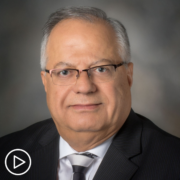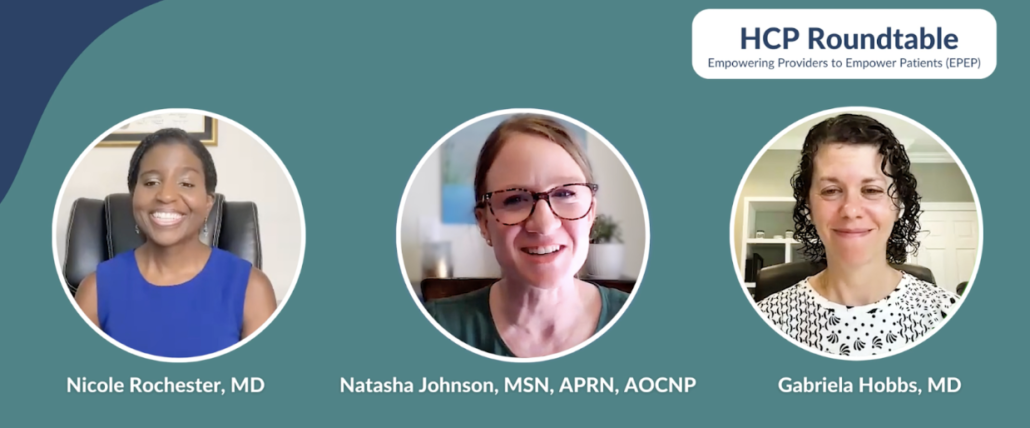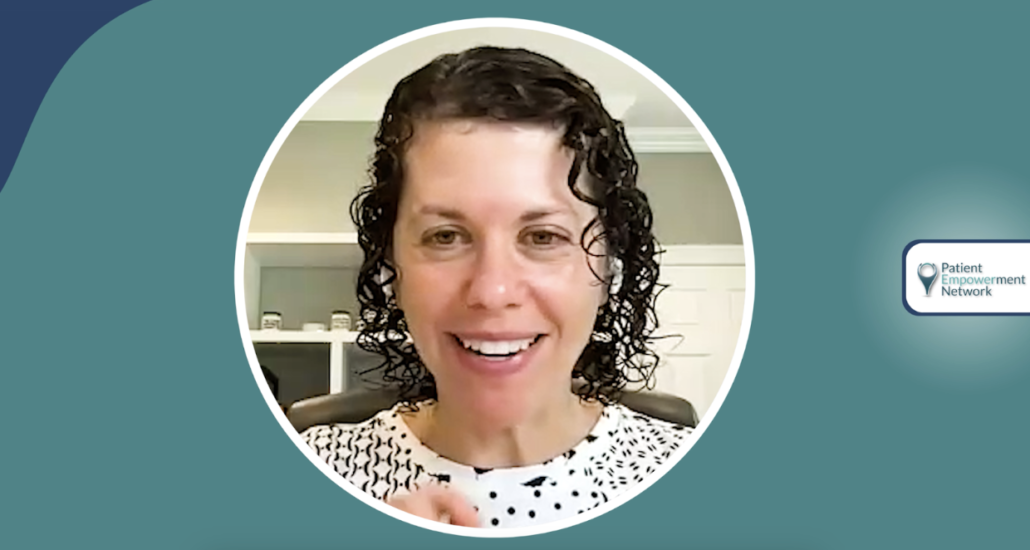Tag Archive for: MPNs
How Molecular Markers Affect MPN Treatment | Advances in Research
How Molecular Markers Affect MPN Treatment | Advances in Research from Patient Empowerment Network on Vimeo.
Are there new molecular markers being discovered that could affect myeloproliferative neoplasm (MPN) care? Dr. Lucia Masarova explains common MPN driver mutations and what researchers are learning about recently discovered molecular markers, such as ASXL1.
Dr. Lucia Masarova is an MPN Specialist and Assistant Professor in the Department of Leukemia at The University of Texas MD Anderson Cancer Center. Learn more about Dr. Masarova.
Related Programs:

|

|

Expert Perspective | Disease Modification in Polycythemia Vera |
Transcript:
Katherine Banwell:
Dr. Masarova, molecular testing is important for people diagnosed with MPNs and may help provide insight into effective treatment approaches. What are some new areas of research related to molecular markers?
Dr. Lucia Masarova:
Molecular markers are very relevant in our designs or thinking about myeloproliferative neoplasms. Not only treatments, but also the disease qualification or prognostication wherever since the discovery of the so-called driver mutations, which are the mutations responsible for the overproduction of the blood counts and disease pathogenesis.
Among them we have the most common, JAK2 mutation, then also calreticulin, MPL, or in some instances we don’t even understand and call it triple-negative.
There we have learned, over the years, that the amount of the expression, or allele burden, does correlate with the disease behavior outcome. And then our ability to reverse that. So, a chief decrease of the burden is also relevant to the outcome of the patients. So, developing therapies or even putting these as an endpoint for clinical trials is important for our decision-making and moving towards eradication of the disease.
Then there are additional molecular changes, which include non-drivers, which are additional mutations that we have learned and even implemented in the latest prognostic models, some of them are very unfavorable, such as ASXL1, Ezh2, IDH mutations, certain splicing factors.
And those play additional roles, a lot of it we still do not understand, in how the disease is going to ultimately behave. What is their interplay, and how we can interfere with that?
So, learning about the impact of these mutations and the drivers and the other effects that cause the disease evolution will probably become the landmark of this decade and in facing myeloproliferative neoplasms.
And I’m hoping we will develop medications, or we will be able to focus our efforts and our decision-making based on molecular definition, as it’s currently very broadly seen across all cancers. We call it precision medicine where we really define, “How does this look like,” not how we box it in based on morphology. What is it driving? What is it not responding? And what can we do to improve that?
So, I totally see here a big potent and powerful tool to allow us to make the most individualized and customized decisions for our patients to offer them the best outcomes.
Expert Perspective | Disease Modification in Polycythemia Vera
Expert Perspective | Disease Modification in Polycythemia Vera from Patient Empowerment Network on Vimeo.
Is it possible to change the course of disease in polycythemia vera patients? MPN specialist and researcher Dr. Lucia Masarova shares an overview of the research in disease modification, discussing her work as the coauthor in an article entitled Moving Towards Disease Modification in Polycythemia Vera, recently published in the journal Blood.
Dr. Lucia Masarova is an MPN Specialist and Assistant Professor in the Department of Leukemia at The University of Texas MD Anderson Cancer Center. Learn more about Dr. Masarova.
Related Programs:

|

|

How Molecular Markers Affect MPN Treatment | Advances in Research |
Transcript:
Katherine Banwell:
Dr. Masarova, you are a coauthor in an article entitled Moving Towards Disease Modification in Polycythemia Vera, which was recently published in the journal Blood. Can you share some of the highlights of the article and what it means for PV patients?
Dr. Lucia Masarova:
Disease modification in polycythemia vera. I’m so excited finally being talking about this because we’ve been really, really, really so hungry for this term, although we still don’t know what it means.
So, we group together with lots of experts in the myeloproliferative neoplasm field and try to brainstorm and put together, “What does it actually mean?” And to me, and to all of us, it was to offer our patients the normal or not-normal lifespan without the consequences of the disease that they face. Because we historically divided polycythemia vera into high-risk or low-risk disease based on the age or previous history of thrombosis or clotting complications.
However, there is a huge area of patients that wouldn’t have either, and still suffer tremendously a bad quality of life, and ultimately also face the disease progression to myelofibrosis, which is the most actual complication of long-term polycythemia vera duration.
So, the concept of disease modification would be to actually prevent the complications to even occur. To allow our patient to live free of having the fear of living with a thrombosis or clotting complication or ultimately progress into myelofibrosis. We have to learn how to get there. What are the relevant endpoints of tools for us to utilize to really understand? We have learned a lot from seeing what we call molecular remissions, or control of the JAK2 mutation with certain medications, for example, interferons or latest ruxolitinib (Jakafi), the JAK inhibition, where the decrease of the allele burden, which represents the disease, is correlated with better outcome.
So, that is something that we have to be learning down the road with a longer follow-up. But that basically triggered us to focus on what can we do better? How do we prevent this from even happening rather than only controlling the historically main points of the disease which are presented by the blood counts symptoms and display? And where we are actually failing quite a lot of patients because despite them having a control count, they still don’t have a happy life, and lots of them suffer and complain.
So, this is something to be learned, and this is opening the disease modification not only for polycythemia vera, but also for all patients with myeloproliferative neoplasms, which have a little bit of a different feeling in the whole myeloid malignancies field. Because it is a very long disease, and it could evolve and change, and only now we starting to understand what does actually happen there. Why some people could live for 30 years, and never face any consequences, and the others would progress very fast?
So, disease modification would normally allow us to develop and learn more tools and better biomarkers, but also focus on drugs that are really needed to help with these long-term outcomes of our patients.
Myeloproliferative Neoplasm News and Research Updates
Myeloproliferative Neoplasm News and Research Updates from Patient Empowerment Network on Vimeo.
Dr. Lucia Masarova, a myeloproliferative neoplasm (MPN) specialist and researcher, discusses the latest updates from a recent MPN Congress. Some of the highlights include new learnings in hematopoiesis, JAK inhibitor comparisons, interferon therapy, and the potential for combination treatments in the future.
Dr. Lucia Masarova is an MPN Specialist and Assistant Professor in the Department of Leukemia at The University of Texas MD Anderson Cancer Center. Learn more about Dr. Masarova.
Related Programs:

|

|

Advances in Research | Emerging MPN Therapies on the Horizon |
Transcript:
Katherine Banwell:
Dr. Masarova, you were in New York recently for the MPN congress. Can you share some highlights from that meeting?
Dr. Lucia Masarova:
Yeah. Sure. That was a very interesting and very loaded conference full of experts and great data. I really liked the overall excellent update of all the therapies that currently exist in the MPN space, including polycythemia vera, essential thrombocythemia, myelofibrosis. So, really a broad breadth of JAK inhibitors, their current sequencing, combinations, interferon update. I very much like also the focus of the novel therapies, which actually talked about, for example, the development of the antibody against mutant calreticulin, PIM inhibitors, and a couple others. They are very promising in the space.
There were also very, very relevant clinical data. I think I really, really enjoyed the radiation in hematopoiesis topic. It spurred lots of discussions in the room. And also, fantastic talks about clonal hematopoiesis and its role in patients with myeloproliferative neoplasms and cancers.
Overall, very great data on artificial intelligence because that will be a very needed tool, but also a very worrisome tool, at this point, until you learn how to use it to help our patients. But that showed a very promising effect and ability for us to, for example, predict thrombosis risk in polycythemia vera patients or to distinguish patients with ET versus prefibrotic myelofibrosis, which is still subject to lots of basically subjective analysis from hematopathologist.
And also, the poster section was quite striking and really excellent. You could walk around and see so many interesting data. The match and direct comparisons of JAK inhibitors, particularly the latest approved, momelotinib (Ojjaara), as it compared to safety data which do currently exist in fedratinib (Inrebic) or pacritinib (Vonjo).
Katherine Banwell:
When it comes to MPN research and emerging treatment options, what are you excited about specifically?
Dr. Lucia Masarova:
There is a lot of excitement in the field currently, and it really depends how we put these patients in, as I would call, boxes, but I don’t like the term. We have these less aggressive diseases, such as polycythemia vera and essential thrombocythemia.
Where I’m really excited about the role of interferon, with the approval of ropeginterferon (Besremi), or ropeginterferon in United States as well as Europe, we have opened a door for learning how can we do better.
It is approved for polycythemia vera patients. There are currently clinical trials running in essential thrombocythemia patients, within patients with prefibrotic myelofibrosis. That’s an agent that has an ability to go after the disease clone and hopefully, hopefully eradicate or prevent it. Especially, especially exciting in the terms of preventing it for progression.
Then iron metabolize modifier, hepcidin mimetics, other agents impacting this. It’s very important we finally learn how iron plays the role in these patients and how we can actually improve. Very important area in helping patients requiring phlebotomies and hopefully, hopefully altering the whole disease outcome in the long-term.
For myelofibrosis we live in an era of JAK inhibitors. We are so excited to have four currently approved and we’re looking forward to the combinations where we have now safer and less cytopenic agents that have a role in anemia or thrombocytopenia and hopefully will be able to be combined with others.
So, we could even move the field more into other hematologic malignancies, where in myeloma we use five, six, seven, eight drugs. For myelofibrosis, we still have one. So, I think we have still a lot to do.
And then non-JAK inhibitor combination. Non-JAK inhibitor, a compounds or mechanism of action really tailored to the disease pathogenesis. Calreticulin, excellent topic, which I’m saying maybe in couple years we will be really classifying myeloproliferative neoplasm calreticulin-mutated, but also JAK2-mutated, and we will not be calling them one because hopefully we will find a tool to eradicate calreticulin and to really be able to offer ultimate – what I call ultimate cure.
So, that’ll be something really exciting to come and all of these investigators in MPN fields are so eager to see what – whether the preclinical data we have seen are going to stand in our patients. And that would be really fantastic.
Choosing a Myelofibrosis Treatment Plan | Key Questions to Ask
Choosing a Myelofibrosis Treatment Plan | Key Questions to Ask from Patient Empowerment Network on Vimeo.
When considering therapy for myelofibrosis, where do you start? Dr. Lucia Masarova shares advice and key questions to ask your provider when making myelofibrosis treatment decisions.
Dr. Lucia Masarova is an MPN Specialist and Assistant Professor in the Department of Leukemia at The University of Texas MD Anderson Cancer Center. Learn more about Dr. Masarova.
See More from Evolve Myelofibrosis
Related Resources:

|

Is Stem Cell Transplant the Only Curative Option for Myelofibrosis? |

Myeloproliferative Neoplasm News and Research Updates |
Transcript:
Katherine Banwell:
When considering treatment options, what key questions should patients ask about their proposed treatment plan?
Dr. Lucia Masarova:
What’s the goal of my therapy? That is one of the most important things to know. Patients don’t even know how long they have to be on the medicines. What to do and how does it look when the medicine is still working? What do I need to be looking for in this medicine? And then what are we going to do if it fails? And what does it actually mean when it fails? What is the schedule? How burdensome the treatment is? How often do I have to come?
How often and what do I have to pay? Because the financial burden we have to really, really face the truth. It is very, very, very significant and somebody living with this disease predicates. It’s something we cannot take lightly, and we really have to combine our efforts and help with that. There are fantastic patient support organizations, but is not well-known, and is still in the rare – in rarer field. So, there’s more effort that we do.
When do I need more help? Where to be referred to more experts? What is the role of stem cell transplantations, if ever? So, those are really the key things.
Where do I find reliable resources to learn about my treatment, to learn about the disease? How do I connect with people from the same community? It is a disease with a lower age in a lot of circumstances and really facing this disease in the 30s or 40s or 50s is a really challenging thing. Although we have more and more medications currently, we really do have now to start thinking about their durability, about the safety for long-term, about their assessments for not performing, and where do we place the ultimate cure for stem cell transplants?
And how do we make it actually happen in more and more eligible patients? Because we have to face the truth. It is still not utilized to where it belongs. Patients are not being referred.
Patients are not being transplanted. And they may change with novel therapies. But we have to really consider all of our tools to offer the longest life span and to prevent all the disease trouble that comes with living with MPNs.
Katherine Banwell:
When it comes to clinical trials, where do they fit in in choosing treatment?
Dr. Lucia Masarova:
For me, it’s number one., and always number one.
That’s just the academic centers which are dedicated and focused on developing better and novel and up front and just tailored and customized drugs. But I know that the life is out there and it’s a little bit more challenging for everybody to deal with such a rare disease.
I would definitely say any patient that does not respond to current therapy in terms of uncontrolled symptoms or spleen, or other concerns should be referred and evaluated for participation in clinical trials. It is the only way we could understand what is driving that this is not responding and how could we help the best?
For patients with myelofibrosis, which is the most aggressive myeloproliferative neoplasm, I would definitely put it in. If they are not doing well on number one, JAK inhibitor, whatever is being used, they should be highly encouraged to be referred to centers and evaluated for clinical trials.
We have been developing as others and own strategies to potentiate the benefit and efficacy of the current treatments, as well as agents in what we call salvage or refractory setting.
However, I cannot emphasize enough to really focus on the first track that providers choose for their patients and utilize it to the best ability to avoid frequent or quick switching. Because in a salvage or refractory setting we cannot offer the same benefit we could offer upfront. We are pushing the disease, maybe being less responsive, maybe more refractory, if we don’t handle the medication we have currently on the table to the best ability.
Those are excellent medications, fantastic drugs, but there are shortcomings in each and every one of them. And we could do better to really start thinking about what has happened with the medication, why is it failing the patient, and what else could we do? And that’s only possible in the clinical trial setting, especially in such a rare disease as myeloproliferative neoplasms are.
Katherine Banwell:
Why is it important for patients to feel like they have a voice in their treatment options?
Dr. Lucia Masarova:
Because it’s about the patients. I would say, as I always say to my patients, “Nobody’s a better advocate for you than you.” I really, really, really like working with patients. They are educated. They understand where to find resources. They’re not afraid to ask. That challenges all of my team and everybody to really be engaged. They know when to notify me. Not to be quiet when they need something. And really raise their voice when something doesn’t work.
Patients know their bodies more than anybody can. And no data, no boxes, no books can ever tell me how it actually is. It’s not by chance we have two ears to listen and one mouth to talk.
So, we have to really listen what the patient has to say and take all the abilities, the resources, the knowledge, the capabilities to really make the best thing for the patients, because it is ultimately and only about that.
Is Stem Cell Transplant the Only Curative Option for Myelofibrosis?
Is Stem Cell Transplant the Only Curative Option for Myelofibrosis? from Patient Empowerment Network on Vimeo.
Is there a cure for myelofibrosis? Dr. Lucia Masarova explains the role of stem cell transplant for the treatment of myelofibrosis and reviews additional therapies for patients who do not qualify for the procedure, such as JAK inhibitor therapy.
Dr. Lucia Masarova is an MPN Specialist and Assistant Professor in the Department of Leukemia at The University of Texas MD Anderson Cancer Center. Learn more about Dr. Masarova.
See More from Evolve Myelofibrosis
Related Resources:

|

Choosing a Myelofibrosis Treatment Plan | Key Questions to Ask |

|
Transcript:
Katherine Banwell:
Dr. Masarova, stem cell transplant is sometimes recommended for people with myelofibrosis. Is this still the closest option to cure for those patients?
Dr. Lucia Masarova:
I would say so, as much as we don’t like it. We would like to develop novel conservative, less aggressive, that we call procedures or drugs. Stem cell transplants still represent a long-term cure for patients that are eligible.
Katherine Banwell:
What about for patients who don’t qualify for stem cell transplant? What are effective long-term treatments for them?
Dr. Lucia Masarova:
That’s a very, very important question and topic. The key point here is the long-term because long-term is a little difficult term in conservative management of myeloproliferative neoplasm, particularly when it comes to myelofibrosis.
With the development of JAK inhibitors, the longest experiences we have with the first one called ruxolitinib or Jakafi, we have seen prolonged outcomes in survival so patients could live longer than expected before.
However, it’s not forever. So, that’s why we are trying to develop novel strategies where I see a lot of roles of combinations of JAK inhibitors and other correlative compounds, such as bromodomains inhibitors or hypomethylating agents or others that would affect the pathways that we are missing currently to cover with the JAK inhibition. And that ultimately leads to medication failures and patients being refractory and then having a shortened lifespan.
So, I’m hoping we will develop something for long-term. Particularly promising a very, very interesting concept is with the calreticulin where we are developing monoclonal antibodies or vaccines because we have seen and discovered calreticulin driver to be a targetable thing that causes immunogenicity.
But I do really hope that we will move forward with these discoveries and the JAK mutate or other drivers causing myeloproliferative neoplasms to offer long-term management.
Myelofibrosis Therapies in Clinical Trials | BET Inhibitors
Myelofibrosis Therapies in Clinical Trials | BET Inhibitors from Patient Empowerment Network on Vimeo.
What are BET inhibitors? Dr. Lucia Masarova, an MPN specialist and researcher, explains what BET inhibitors are and discusses the role these therapies may play in the treatment of myelofibrosis.
Dr. Lucia Masarova is an MPN Specialist and Assistant Professor in the Department of Leukemia at The University of Texas MD Anderson Cancer Center. Learn more about Dr. Masarova.
See More from Evolve Myelofibrosis
Related Resources:

Is Stem Cell Transplant the Only Curative Option for Myelofibrosis? |

Choosing a Myelofibrosis Treatment Plan | Key Questions to Ask |

How Molecular Markers Affect MPN Treatment | Advances in Research |
Transcript:
Katherine Banwell:
We’re starting to hear more about BET inhibitors. Could you explain what they are and how they work to treat myelofibrosis?
Dr. Lucia Masarova:
BET inhibitors are abbreviations for bromodomain inhibition, which is a very relevant regulator of transcription factors that play a significant role for making the blood cells.
So, just differentiation of red cells or platelets, as well as very significant role in cytokines regulation. We know that myelofibrosis is a disease that is defined by overactive JAK-STAT Pathway that ultimately leads to increased cytokines.
However, there are other pathways that play a significant role, and one of the very major ones is NF-kB, where the BET inhibitor come in play because they target it and help us to decrease the cytokine load as well as alter the differentiational block that happens in the red cells or megakaryocytes or platelets in these patients.
So, the combination of bromodomain inhibition, or even using it as a single agent on or after refractory I think is a very promising tool that excludes the only JAK inhibition that we’ve been developing for diseases and opens the door for combination strategies that we were so many years thinking through and trying to find out.
This is really the most promising compound or way of altering the disease background that we can see.
Nurse Natasha Johnson: Why Is It Important for You to Empower MPN Patients?
Nurse Natasha Johnson: Why Is It Important for You to Empower MPN Patients? from Patient Empowerment Network on Vimeo.
What are some ways that myeloproliferative neoplasm (MPN) oncology nurses and other MPN care team members can aid in empowering patients? Oncology nurse practitioner Natasha Johnson from Moffitt Cancer Center how she helps patients and their loved ones become more involved in care and treatment decisions.
See More from Empowering Providers to Empower Patients (EPEP)
Related Resources:

|

|

Dr. Ana Maria Lopez Why Is It Important for You to Empower Patients |
Transcript:
Natasha Johnson:
So I’m an encourager, so I will encourage patients to be involved, get their loved ones involved, educate themself on the disease on the common symptoms, on treatments, and then ways to alleviate those symptoms. So I would encourage them too, to keep on living. Let’s do what we can to improve the symptom burden so you can keep on living. And I think this is important, because I believe that empowered patients are very well-informed, and they are the top key player in their care. They’ll share their goals of care, which makes them better prepared to work with the healthcare team to create an individualized plan of treatment for them.
Dr. Gabriela Hobbs: Why Is It Important for You to Empower MPN Patients?
Dr. Gabriela Hobbs: Why Is It Important for You to Empower MPN Patients? from Patient Empowerment Network on Vimeo.
What are some ways that can myeloproliferative neoplasm (MPN) care providers can help empower their patients? MPN expert Dr. Gabriela Hobbs from Dana-Farber/Harvard Cancer Center shares her perspective of how she educates her patients. Dr. Hobbs explains her methods of empowering all her patients in their care – whether they’re newly diagnosed, needing long-term MPN care, or going on to seek care from other clinicians.
See More from Empowering Providers to Empower Patients (EPEP)
Related Resources:

|

|

Dr. Ana Maria Lopez Why Is It Important for You to Empower Patients |
Transcript:
Gabriela Hobbs, MD:
I think that empowering patients is really important in developing an excellent longitudinal relationship with an MPN patient. And the way that I like to empower my patients is through education. And that starts with the first meeting with the patient when they’re recently diagnosed, or maybe they’re seeking you out for another opinion because maybe something is going not well with their disease.
And so that first visit, I really like to spend a lot of time educating about what MPNs are, the different types, the things that we worry about, the possibility of disease progression, and then spending a lot of time talking about the different treatment options that exist. As well as spending a lot of time talking about how patients can maximize their quality of life with both pharmacologic interventions as well as lifestyle modification. And so education really is at the center of empowerment for patients.
And I think that that gives them a lot of control over their disease and prepares them for additional visits with me or with other clinicians if they’re seeking other care from other clinicians as well, especially those patients that maybe travel from far away. And so education during that visit is important, but also talking to patients about how to prepare for additional visits. So I talk to patients a lot about taking track of their symptoms, keeping track of how they’re feeling, how they feel with the medication, with perhaps a change in medication, how they feel like their symptoms are changing over time. Talking to them about the MPN symptom assessment form, and making sure that they can utilize that form to keep track of how they feel.
And then also asking questions…If they don’t ask questions during the encounter, make sure that they write down those questions in a notebook so that when they do go to see their clinician at the next appointment, they can make the most of that encounter by knowing that they’re going into that encounter, prepared with questions and able to summarize the way that they’ve been feeling over the last couple of weeks or months since their last appointment. So education is really always at the center of empowerment.
Yolanda’s Story: My Path to a Myeloproliferative Neoplasm Diagnosis
Yolanda’s Story: My Path to a Myeloproliferative Neoplasm Diagnosis from Patient Empowerment Network on Vimeo.
Latina essential thrombocythemia (ET) patient Yolanda had many symptoms before receiving her ultimate diagnosis. Watch as she shares the symptoms she experienced, her long path to diagnosis, and her lessons learned about patient empowerment.
Related Resources:

|

La historia de Yolanda: mi camino hacia un diagnóstico de neoplasia mieloproliferativa |

|
Transcript:
My name is Yolanda, and I was diagnosed in my mid-40s with essential thrombocythemia (ET), a myeloproliferative neoplasm. I’m a Latina woman, and my path to diagnosis took an extended time.
Thinking back on my journey, my symptoms began with severe headaches and dizziness that made it too difficult to finish my work. I also experienced debilitating fatigue that would either keep me in bed for a day, or I’d feel like my vision and thinking were in a fog. It all felt very strange, and I saw my doctor about the symptoms, but he prescribed antibiotics for an infection. Then later I felt numbness and tingling in my hands and feet and then pain in my abdomen. Finally, my doctor decided to run full blood work to see which levels might be abnormal, and that was followed with a bone marrow biopsy to further investigate.
When I finally received my diagnosis with essential thrombocythemia, I felt some relief but also a sinking feeling and dread of what might be ahead for me. I feel like one issue with getting diagnosed may have been that I looked healthy. Maybe my doctor would have ordered the blood work sooner if I didn’t look well. But I try to look forward rather than back. An MPN specialist was recommended to me, and he initially put me on low-dose aspirin.
Then I was prescribed hydroxyurea (Hydrea). I’ve been doing well and feel grateful to have treatment options. But if my disease progresses to a point where I need other options, I’ve already decided that I’ll consider participating in a clinical trial. I feel like I’ve been relatively lucky and want to share my cancer story to help others.
Some of the things I’ve learned on my MPN journey include:
- Empower yourself by asking your doctors questions about your MPN and what to expect before, during, and after treatment.
- Learn about clinical trial options. There may be programs that will help you with travel, lodging, and other uncovered expenses. And clinical trials may provide an option for your MPN if you’ve already used all other options.
- You are the person in charge of your health. If you feel like something is wrong in your body, advocate for yourself. Ask for more testing to find out what is wrong.
- Be careful about where you look for cancer information. Use credible sources like MPN Research Foundation, The Leukemia & Lymphoma Society, and Patient Empowerment Network.
These actions were key for staying on my path to empowerment.
Share Your Feedback
Create your own user feedback survey
Empowering MPN Providers to Empower Their Patients

Empowering patients is at the heart of efforts at Patient Empowerment Network (PEN), and work toward reducing health disparities is part of conversations among healthcare professionals. With this in mind, PEN has taken on a new initiative for myeloproliferative neoplasms (MPNs), the MPN Empowering Providers to Empower Patients (EPEP) initiative. The program expands PEN’s reach to healthcare professionals with the goal to improve physician-patient communication; shared decision-making; and the role that MPN patients, survivors, care partners, and healthcare professionals each play in the shared decision-making process.
The EPEP initiative includes the following resources:
- Needs Assessment outlines key factors that enable patient empowerment, attributes of an empowered patient, and advice for healthcare professionals to perform a needs assessment for each patient.
- EPEP Roundtables with Dr. Nicole Rochester and MPN experts Dr. Gabriela Hobbs and Natasha Johnson as they discuss a range of topics including how to help your MPN patients play an active role in managing their care, healthcare provider recommended strategies for managing disease burden, the importance of advanced practice clinicians on the MPN health care team, clinical trials and why it’s vital for nurses to address this topic with patients and families, and cultural humility in action.
- EPEP Resources provides the resource guide, infographics, blog, and other resources to improve patient care
- EPEP Portal utilizes PEN’s robust resource library and that of numerous trusted advocacy partners to create a vetted list of patient education resources. PEN delivers a curated PDF according to your interests efficiently to your inbox.
Key Takeaways to Help Empower MPN Patients
PEN had the opportunity to interview experts Dr. Gabriela Hobbs and Natasha Johnson to learn about some of their expertise. They shared their perspectives about vital ways that they work with patients to help empower them and to work toward the best personalized care for each patient.
The art of listening to patients is an essential part of empowering patients in their care journeys. Expert Dr. Gabriela Hobbs from Massachusetts General Hospital shared her perspective about listening. “…I think knowing where your patient is emotionally, what’s important to them, what are their worries, is really important, so you can have a conversation where you’re not just speaking about the things that you as a provider think is important, but really also listening to where the patient is coming from, and so that you can make sure that you’re appeasing their anxieties and whatever decision you make is consistent with both what you think is medically important, but also with what’s really important for the patients. I think listening is really at the core there.”
Of course, nurse practitioners often serve as valuable members of the MPN care team. As a nurse practitioner, Natasha Johnson shared her perspective in empowering MPN patients. “…I think that we spend a ton of time educating them to make sure that they really understand this disease, the symptoms that go along with it, the treatments that go along with that, and once we have a good confidence that they understand everything, lead them into discussing what their goals of care are, and then we take all that information together, and we create a treatment plan specific to that patient, really aiming to improve their quality of life and overall survival.”
Johnson also shared about the benefits of seeing an MPN specialist. “…I really think there’s a benefit to seeing an MPN expert that is at a national cancer center, academic center. I do think there is some more time allotted to those visits, especially the consults and first appointments for the patient, and we kind of start this with my doctor and other providers of assessing how much does the patient even know to begin with? So that can direct us where to start. And then how deep do they want to go.”
Helping to educate MPN patients, of course, can take a variety of different forms. Johnson explained some of the actions that she takes to help her patients. “…I write a lot of things down for my patients when I see them, I think visuals are really helpful, provide literature, I tell them what websites to visit. A lot of times, they just Google their doctor, which is great because they can find them and listen to their own lectures, and they really learn a lot. So just guiding them to those resources. I do think it’s important, too, to give them something like the total symptom score form. Just having that visual of, these are what is common, and then they can think about that between visits, but I think all of those things really help to educate them and get them involved.”

MPN Care Team Best Practices for Patients
Tracking symptoms and preparing for office visits are key tasks for MPN patients. Dr. Hobbs explained how essential these tasks are for patient empowerment. “…for those patients that are very symptomatic, for example, keeping track of their symptoms over time, writing down notes about how they felt, what they think made something better, made something worse, how they’re responding to these medications, questions that they may have, and writing all of that down helps them be more empowered patients. They can advocate for themselves in a more organized way when they do go see either me or another clinician. So they come in fully prepared with the information and the questions that they want to get out of that visit.”
Dr. Hobbs has experienced the value of the symptom assessment form. “I think clinicians are busy and sometimes feel like having a tool to ask those questions is maybe too burdensome. I personally find that the MPN symptom assessment form is a quick form, it’s easy to complete, it can be given to a patient, there’s a piece of paper while they’re waiting for you.”
And Dr. Hobbs shared the benefits she’s experienced with the use of the form. “And that also directs the conversation because it really just gives numbers, makes it objective, and then can really start that conversation. And so remembering that we do have this tool, it actually can help cut down time to the visit and make it more focused, and it’s helpful to…empowers the patient and make sure that you really are asking about all of those symptoms, and just making sure that you don’t just assume that a patient has or doesn’t have a symptom, but really saying, ‘Are there any other symptoms that you’ve noticed?’”
Dr. Hobbs has also witnessed the value of care partners being involved in MPN care conversations about symptoms. “…the spouse is like, ‘But remember, you really haven’t been having your dinner, and remember how you were complaining about how your stomach was hurting every time you ate. And you say you’re not itchy, but every night when we’re watching TV, I turn around and I see that you’re scratching.’ And so I think that’s also a really important tool to make sure that you make use of the family members, because they really know what’s going on if the patient is not willing to share as much or doesn’t like to complain.”

Advocacy for Cultural Humility
Cultural humility is a process of listening and learning about patients. Dr. Hobbs shared her perspective. “…there’s all sorts of history in this country, especially about clinical trials. And I think coming into those encounters, like I said at the beginning of our conversation, taking into account that you really do know your patient. But sometimes, you don’t know the patient as well. You’re getting to know them, and you need to make a decision. Just listening, being humble, being aware, trying to understand where the patient is coming from.”
Dr. Hobbs continued to share about taking this vital time to learn about your patients’ ways of thinking. “I think sometimes, especially when you’re trying to make a decision quickly and you find that there’s some friction, I think taking some time to say, ‘Alright, where is that coming from?’ And perhaps I’m coming across too strong with this recommendation to do this clinical trial and there’s maybe something that I need to explore, and so just keeping an open mind and trying to just ask questions, ‘Where are you coming from? What’s important to you? Why are you hesitating? Or is there something that I can explain in a different way?’”
Even though MPN treatments have experienced increases in quantity and efficacy of treatments, vital HCP best practices can go a long way in empowering MPN patients.How can you help your MPN patients play an active role in managing their care? How do we improve clinician-patient communication about symptoms? How should fellow MPN specialists explain disease progression to patients and care partners? We hope healthcare providers can take advantage of these timely resources of the EPEP initiative to work toward equitable and culturally sensitive care for all MPN patients.
See More from MPN | Empowering Providers to Empower Patients (EPEP)
Explaining Myeloproliferative Neoplasm Disease Progression to Patients
Explaining Myeloproliferative Neoplasm Disease Progression to Patients from Patient Empowerment Network on Vimeo.
What is the best way to explain disease progression to myeloproliferative neoplasm patients? MPN experts Dr. Gabriela Hobbs and Natasha Johnson share advice on how they work with patients and families to clearly explain disease progression.
Dr. Gabriela Hobbs is a hematology-oncology physician specializing in the care of patients with myeloproliferative neoplasms (MPN), chronic myeloid leukemia, and leukemia. Dr. Hobbs serves as clinical director of the adult leukemia service at Massachusetts General Hospital and is an assistant professor at Harvard Medical School.
Natasha Johnson, is an Advanced Oncology Nurse Practitioner at Moffitt Cancer Center, where she cares for people living with MPNs with kindness, patience, and humanity. Natasha also speaks at conferences to educate other healthcare professionals about MPN care, research, and treatment.
See More from Empowering MPN Providers to Empower Patients (EPEP)
Related Resources
Transcript:
Nicole Rochester, MD:
I wanted to shift again and start to talk about specifically disease progression. And we know that that is, unfortunately, something that is an important element of MPNs. And so as we talk to fellow MPN specialists, what are you all’s recommendations for how they can best explain disease progression to patients? Are there any specific languaging or specific tactics that you all use, and even things that maybe you shouldn’t say as you are sharing information about disease progression? Either one of you, feel free to go first.
Gabriela Hobbs, MD:
So disease progression, I think is a really challenging topic, because on the one hand, I think it’s really important to educate patients. It’s really important for patients to know that that is a possibility, that it is something that can happen. It’s really challenging to have a patient that has lived with this disease for a long time, hardly even knows the name of that disease. Maybe they were seen elsewhere, etcetera, and then all of a sudden, something’s going wrong and they just weren’t prepared for that. But I feel like that really does need to be balanced by the fact that, thankfully, progression happens infrequently. And so you also…going back to what we were saying before, you want to help a patient to be able to live well with these diseases and not be defined by those diseases. And so one of the things that I try to do with patients is, especially during that initial visit, I spend some time explaining to them what the disease is, that it can progress to myelofibrosis, that it can progress to leukemia. But then I also try to reassure them as much as possible that this is an infrequent event, that the reason why we follow patients in-clinic is so that we can start to notice if there’s disease progression, that it usually happens gradually.
And then I try to say, “You have this information. We can’t necessarily change that at this moment, there are maybe some tools that we can use in the future, but try to put that information in a box in your brain, put the key, put it away, try not to think about that every day when you’re outside of here. Definitely okay to open that back up when you’re with me in the room. If you want to get those anxieties out, that’s fine, but let’s really try to make sure that that’s in the back and not at the forefront of our thoughts.” And kind of going back to one of the things we were discussing before about what the patient thinks is most important, what the clinician thinks is most important. If you ask patients what are they most concerned about with their MPN, oftentimes that response is, “Is my disease going to progress?” And so I think acknowledging that and talking about that is important, but then also reminding patients that over time, they need to, hopefully with your help, or maybe they need additional assistance with therapists or social workers, etcetera, let’s find a way to put that away so that it’s not really at the forefront of our thoughts every single day, because that also ends up being not productive.
Nicole Rochester, MD:
I love that approach, of providing the education, but also that balance that you talked about, Dr. Hobbs. I love the idea of putting it away, putting it in a box [chuckle] and locking it, and then opening it back up when you’re in the safety with your healthcare provider. That’s beautiful.
Do you have anything to add to that, Ms. Johnson?
Natasha Johnson:
I completely agree. Your example there of putting it in the box, I’m going to use that in clinic. [laughter] I think it’s a great visual for patients. Because like you said, they’re very scared, and it can control them and take over, and we don’t want the disease to take over their life. Still live. Enjoy.
Share Your Feedback:
Create your own user feedback survey
Are There Non-Pharmacologic Strategies for Managing Myeloproliferative Neoplasms?
Are There Non-Pharmacologic Strategies for Managing Myeloproliferative Neoplasms? from Patient Empowerment Network on Vimeo.
What non pharmacologic strategies for managing myeloproliferative neoplasms are recommended? Dr. Gabriela Hobbs shares her approach in talking with her patients.
Dr. Gabriela Hobbs is a hematology-oncology physician specializing in the care of patients with myeloproliferative neoplasms (MPN), chronic myeloid leukemia, and leukemia. Dr. Hobbs serves as clinical director of the adult leukemia service at Massachusetts General Hospital and is an assistant professor at Harvard Medical School.
Natasha Johnson, is an Advanced Oncology Nurse Practitioner at Moffitt Cancer Center, where she cares for people living with MPNs with kindness, patience, and humanity. Natasha also speaks at conferences to educate other healthcare professionals about MPN care, research, and treatment.
See More from Empowering MPN Providers to Empower Patients (EPEP)
Related Resources
Transcript:
Nicole Rochester, MD:
Dr. Hobbs, are there any non-pharmacologic strategies that you endorse? And I’m asking you specifically because I think a lot of times, patients and care partners think that physicians aren’t well-versed in non-pharmacologic therapies or that we don’t endorse non-pharmacologic therapy. So I’m curious to know if there are any that you tend to recommend to your patients with MPNs.
Gabriela Hobbs, MD:
I love this question, and I’m glad to have an opportunity to talk about it, and I loved everything that Ms. Johnson said. For many years, I’ve felt in my practice like I’m a primary care doctor and I’m talking to patients about diet and exercise, [chuckle] especially for the patients that have essential thrombocythemia and polycythemia vera or low-risk myelofibrosis, those diseases really are diseases that I think about as another cardiovascular risk factor. And when we’re talking to patients that have cardiovascular risk factors, like obesity, like hypertension, like hyperlipidemia, diabetes, etcetera, what do we talk to them about? We talk about lifestyle modification. And I think that that fits in beautifully in the care of a patient with an MPN because there’s nothing like getting a diagnosis to take away control from your life. And so giving patients control back by saying, “Actually, you do have control over this disease by changing your lifestyle, by living an active healthy lifestyle and having a well-balanced diet,” I think can actually be very helpful.
One of the things that we don’t talk a lot about in MPNs, ’cause we’re focused on cell signaling and new fancy medications, is just the basics, lifestyle modification. And so I’m a huge fan of that holistic approach. I loved what Ms. Johnson said about, “Don’t let yourself be defined by this disease.” Let’s really find a way of improving your quality of life and maximizing how you live your days. And so I think talking to them about lifestyle modification is something that is really near and dear to my heart. We have a clinical trial now helping patients to really change their lifestyle, get more active and eat more healthily, and I think that those things are actually really, really important. Many of my patients, the first thing they do when they get diagnosed is they want to go and find that magical supplement that’s going to change their natural history of their disease. And although I can’t really say if any of those supplements are going to be helpful or not, I can for sure say that there is no harm, and there’s probably benefit to staying active and also to having a more plant-based, less processed food diet. And I think that that really goes a long way in terms of helping patients to improve their symptoms, feel less tired and feel less anxious, also feel like they have more control over what’s going on with them.
Share Your Feedback:
Create your own user feedback survey






